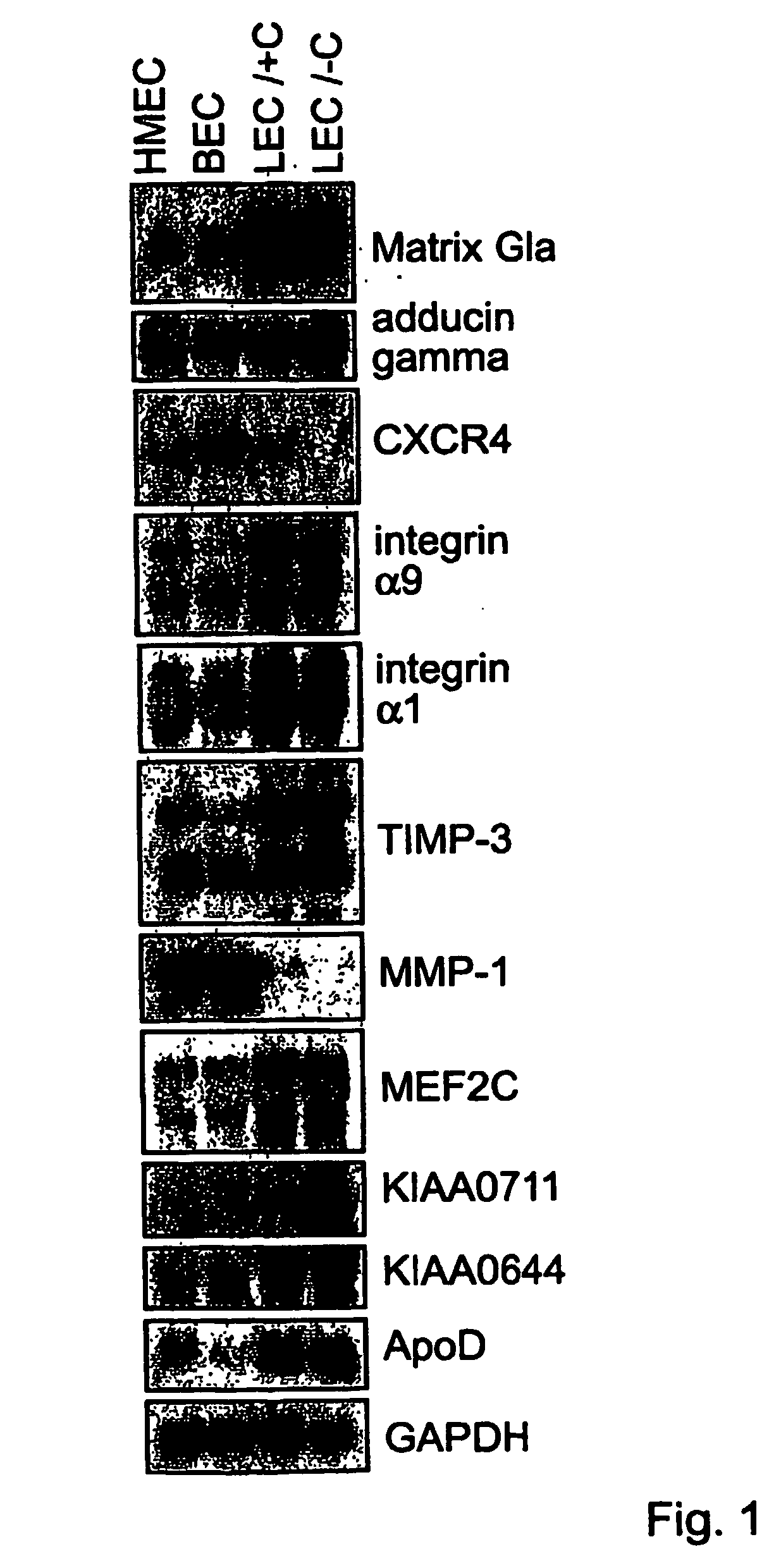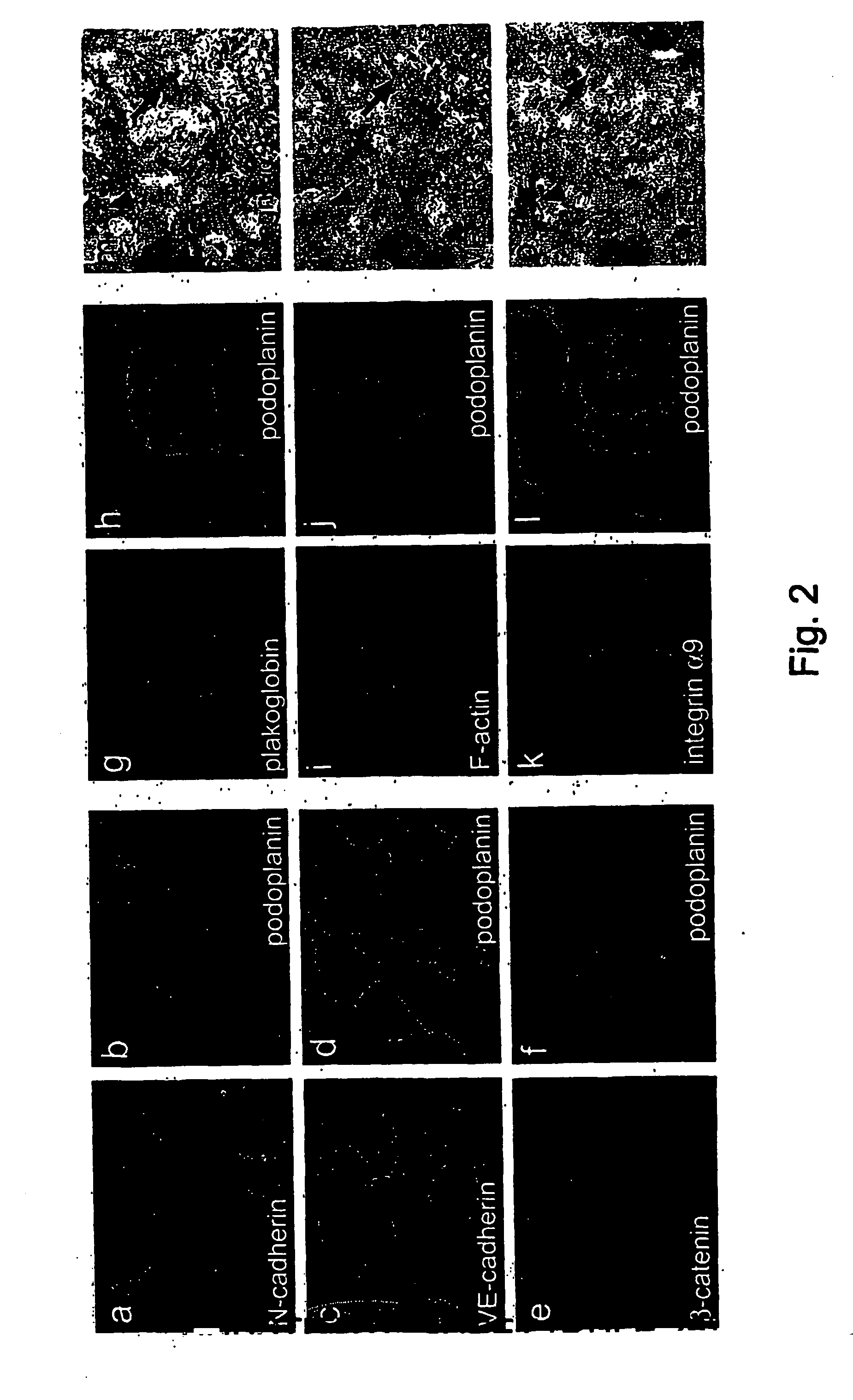Lymphatic and blood endothelial cell genes
a technology of lymphatic and blood endothelial cells and proteins, which is applied in the direction of antibodies, peptide/protein ingredients, fungi, etc., can solve the problems of slow progress in understanding and manipulating the lymphatic system, tumors or malformations of the lymphatic system, and little is known about the mechanisms leading to metastasis via the bloodstream or via the lymphatic system, so as to achieve the effect of modulating the overall activity of the target gene produ
- Summary
- Abstract
- Description
- Claims
- Application Information
AI Technical Summary
Benefits of technology
Problems solved by technology
Method used
Image
Examples
example 1
Identification of Differentially Expressed Genes
[0174] Blood vascular and lymphatic endothelial cells (BEC and LEC, respectively) were isolated from cultures of human dermal microvascular endothelial cells using magnetic microbeads and antibodies against the lymphatic endothelial cell surface marker podoplanin (Breiteneder-Geleff, S., et al., Am. J. Pathol. 154:385-394 (1999); Makinen, T., et al., EMBO J. 20:4762-4773 (2001)). The purities of the isolated BEC and LEC populations were confirmed to be over 99% as assessed by immunofluorescence using antibodies against VEGFR-3 or podoplanin. The isolated cells were cultured for a couple of passages, and RNA was extracted from the cultures and used for hybridization with oligonucleotide microarrays containing sequences from about 12,000 known genes, ie., approximately ⅓ of the total number of all predicted human transcripts.
[0175] As expected, podoplanin, desmoplakin I / II and the macrophage mannose receptor, which are known lymphatic ...
example 2
Bec-Specific Expression of Genes Involved in Inflammation
[0178] Endothelial cells play an important role in several steps of the inflammatory response. They recruit leukocytes to inflammatory foci and specialized endothelial cells (high endothelial venules) are responsible for the homing of lymphocytes to the secondary lymphoid organs. In addition, endothelial cells modulate leukocyte activation and vice versa, and they can become activated by molecules secreted by the leukocytes. Consistent with their activation in cell culture, the BECs expressed high levels of pro-inflammatory cytokines and chemokines (stem cell factor, interleukin-8, monocyte chemotactic protein 1 (MCP-1)) and receptors (UFO / axl, CXCR4, IL-4R) see Table I. CXCR4 and its ligand, stromal cell-derived factor-1 (SDF-1), play important roles in the trafficking of normal lymphocytes, monocytes, and hematopoietic stem- and progenitor cell, targeted inactivation of either CXCR4 or SDF-1 results in impaired cardiogenesi...
example 3
Differences in Cell Adhesion, Cell-Cell Interaction and Cytoskeletal Molecules
[0179] The most striking differences detected between the BECs and LECs was the expression of genes involved in cytoskeletal and cell-cell or cell-matrix interactions (see Tables 3 and 4). For example, N-cadherin, which is involved in the interaction of endothelial cells with SMCs and pericytes (Gerhardt, et al., Dev. Dyn. 218:472-479. 2000), was detected specifically in BECs. This is consistent with the fact that the lymphatic capillaries are not ensheathed by SMCs. In immunostaining, N-cadherin was detected exclusively in the BECs, whereas VE-cadherin was present in both cell types (FIG. 2a-d). The cytoplasmic domains of cadherins interact with β-atenin, plakoglobin (γ-catenin) and p120ctn, which link them to the actin cytoskeleton via α-actinin, vinculin, ZO-1, ZO-2 and spectrin (Provost, E. & Rimm, Curr Op. Cell Biol. 11:567-572. 1999). BECs expressed significantly higher levels of β-catenin (FIG. 2e,...
PUM
| Property | Measurement | Unit |
|---|---|---|
| Temperature | aaaaa | aaaaa |
| Temperature | aaaaa | aaaaa |
| Fraction | aaaaa | aaaaa |
Abstract
Description
Claims
Application Information
 Login to View More
Login to View More - R&D
- Intellectual Property
- Life Sciences
- Materials
- Tech Scout
- Unparalleled Data Quality
- Higher Quality Content
- 60% Fewer Hallucinations
Browse by: Latest US Patents, China's latest patents, Technical Efficacy Thesaurus, Application Domain, Technology Topic, Popular Technical Reports.
© 2025 PatSnap. All rights reserved.Legal|Privacy policy|Modern Slavery Act Transparency Statement|Sitemap|About US| Contact US: help@patsnap.com



